"We shall go to Erfurt. I want to come back with the freedom to do what I want in Spain; I want to be very precise with Russia regarding our involvement in the Levant. Prepare me an agreement which will satisfy the emperor Alexander, one which above all must be directed against England and in which I shall be at ease regarding the other points. I shall help; we shall not want for prestige.” Napoleon to Talleyrand
In my last post I promised a few photos of sites associated with the 1808 Congress of Erfurt, an event that we would describe today as a summit meeting. Napoleon was looking for a free hand in Europe, and trying to impress Tsar Alexander. It didn’t work out, because as you know, Napoleon and Alexander never exactly became BFFs. There’s a good summary of the meeting here.
One of the venues we saw was the Kaiseraal, a concert venue which was used by Napoleon to impress his guests. The Comedie Francaise was summoned from Paris to stage no less than sixteen plays and performances during the Congress (all series, the Emperor did not want trivial comedies and dramas). Napoleon complained of the expense of this “mass levy of thespians”, but felt that it was worth it to awe the kings of Europe with France’s glory. While I was able to sneak into the lobby, and mug with a mannequin of Napoleon in the lobby (fortunately that picture is still on Madame’s camera), I wasn’t able to see anything else.
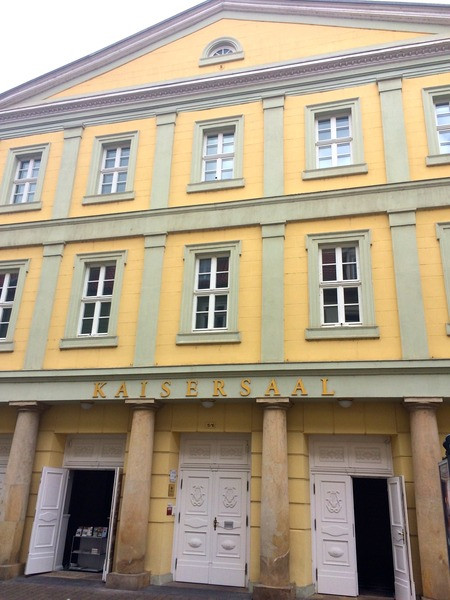
In later years, Paganini and Liszt both performed here. As you can see from this link, the Kaisersaal is still a pretty swish place today.
Much of the conference took place at the Governor’s Palace in Erfurt. The building is actually two, a Baroque-era building on the left and a Renaissance era building on the right (I hope I remembered that correctly), joined in the centre by a newer entrance hall. Besides Tsar Alexander and the other VIPs of the day, Napoleon and his court would have passed in and out of here, including Soult, Lannes, Berthier, and Davout. Today this building is used by the government of the German province of Thuringia, so the only people we saw passing in and out were youngish looking bureaucrats.
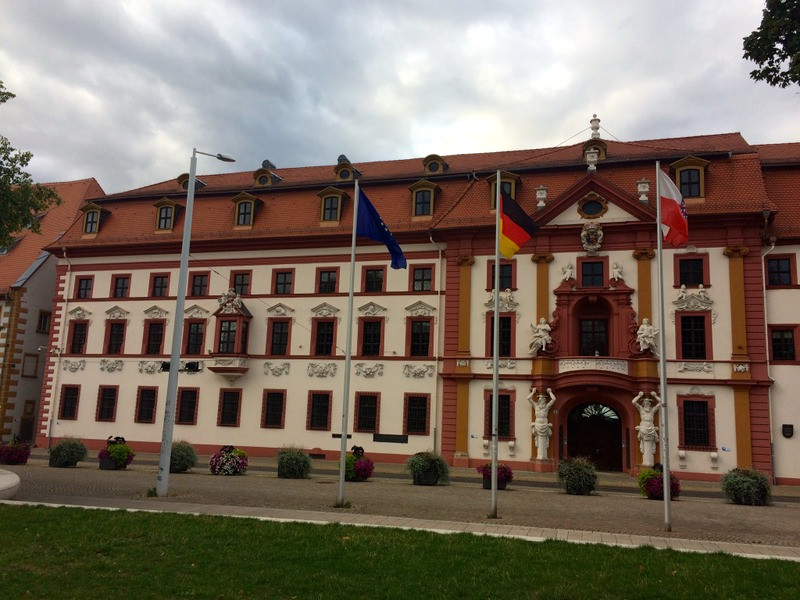
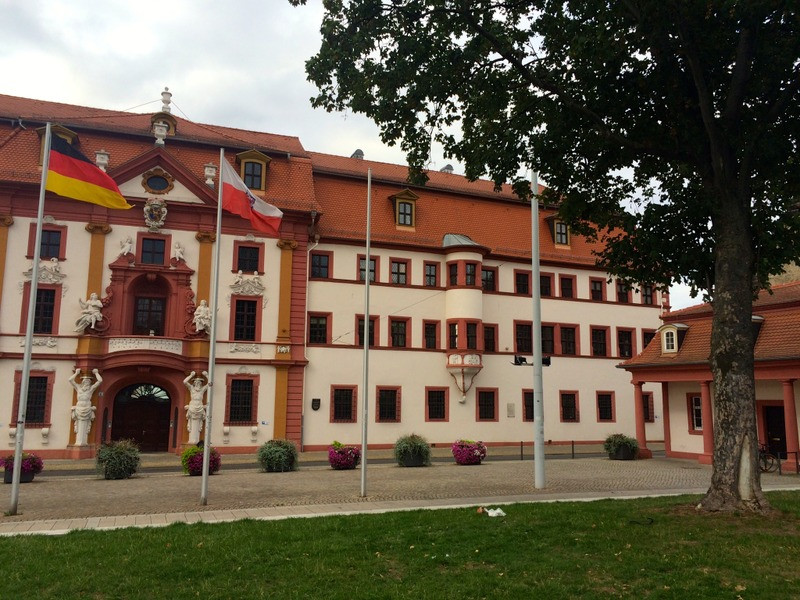
It was here that Napoleon had his famous meeting with Goethe, Germany’s secular saint of literature and culture. It’s interesting to think that Napoleon wanted to impress Goethe. It’s hard today to imagine any world leader going out of his or her way to impress, say, a Nobel prize winning novelist. I guess cultural legitimacy was as important to Napoleon as political legitimacy was. Napoleon also wanted to display military legitimacy, and some of his best regiments (6th Cuirassiers, 8th Hussars and of course the Old Guard) drilled and took part in reviews and inspections during the Congress. A few years later, after the Battle of Nations, these once proud regiments would straggle through Erfurt on their way to the Rhine, little more than a gang of thieves, scandalizing Napoleon (and no doubt the locals) with their conduct.
Speaking of Goethe (and who doesn’t speak of him?), the great man of letters was also a bureaucrat, responsible for managing the important east/west road that went through Erfurt. He often stayed in this building next store to the Governor’s Palace.
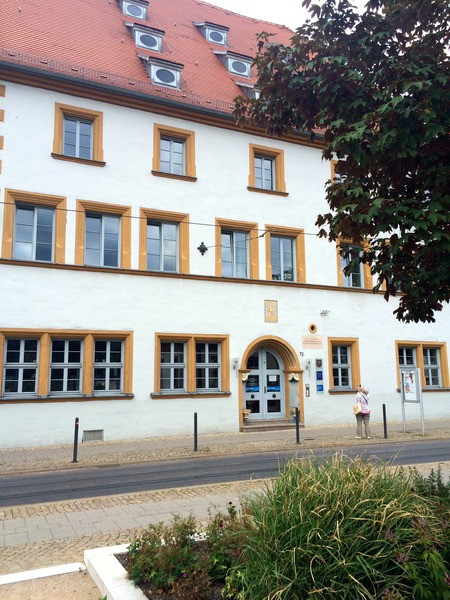
As you can see, Germans still think of Goethe as kind of a big deal.
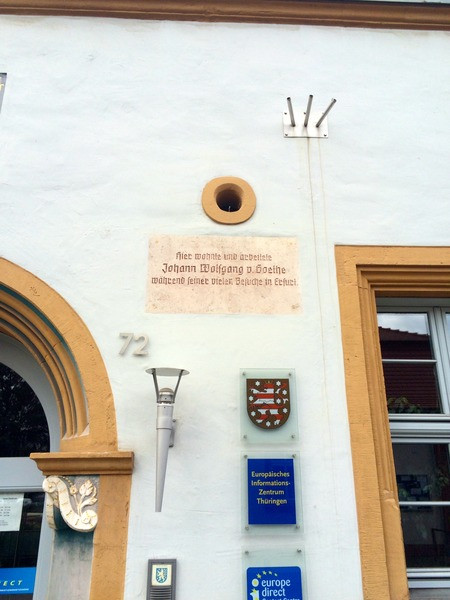
One more Napoleonic tidbit for you before we bid “Auf wiedersehen” to lovely old Erfurt. Madame and I were strolling in a lovely park not far from our apartment, when I noticed my map showed something called the “Muffling denkmal” in the same park. We found this little structure off in a corner. Why here? Wikipedia, always a good source for scholars, says that this hero of Waterloo died on his estates near Berlin, but the editor of an early translation of his memoirs reports that the estate was near Erfurt.
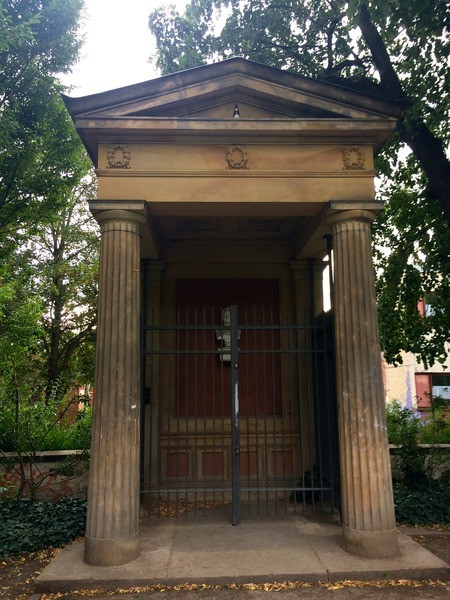
The great man, sporting some fine sideburns. He looks like he was a pugnacious sort of fellow, making me think that the actor in the film Waterloo didn’t quite do him justice.
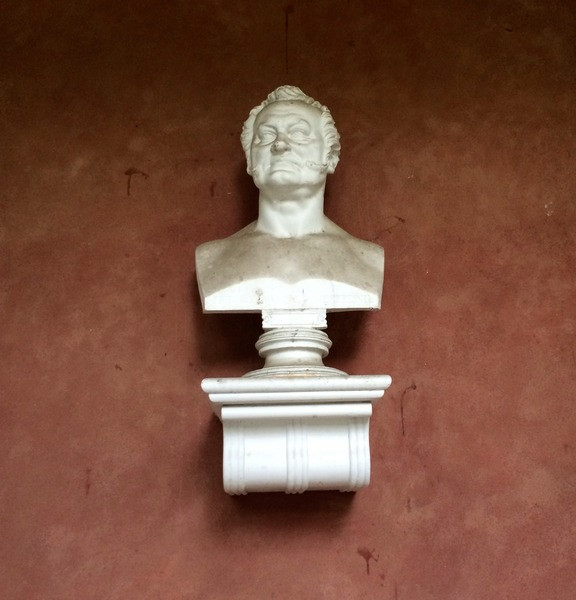
Finally, you may be asking, what were the hobby stores in Erfurt like? I only saw one. Didn’t go into it. But what a lovely street, with a ubiquitous church at the end of it. In Canada we whine and moan about taxes, and consequently many streets in newer developments are built without sidewalks. I gather the same is true of America. The Germans don’t seem to have a problem paying for lovely, walkable streets.
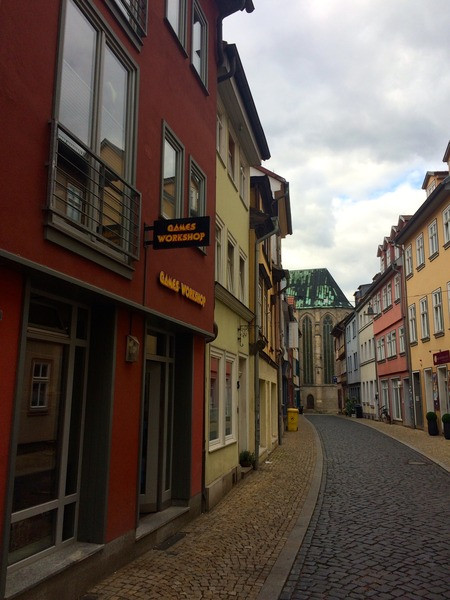
Auf wiedersehen!

A very interesting post and some excellent photos. How important do you think this 'following in the footsteps' is? Totally necessary for understanding a period, or a nice-to-have extra?
ReplyDeleteHello Ed:
ReplyDeleteThat's a terrific question and one that was much on my mind because the reason I went to Erfurt was to participate in a conference panel on military pilgrimage. The conference was nominally about religion, but my fellow panelists included anthropologists and sociologists, and we were asking, what attracts people to places? Specifically, why do soldiers, veterans, reenactors, widows and descendants visit places associated either with religion or with military history (e.g., a cemetery or battlefield). Scholars of pilgrimages assume that a place becomes a magnet for pilgrims, who we may call intentional visitors rather than the occasional visitors who make up the bulk of tourists, because they are drawn to a certain place, So, Polish reenactors going to Monte Cassino (one of my colleagues' papers) or young Aussies going to Gallipoli could be examples of military pilgrims. What is the attraction? How is it different from a traditionally religious pilgrimage to a place like Lourdes or Jerusalem? The obvious difference is that there isn't a connection to a formal definition of the divine (e.g., the Virgin at Lourdes, Jesus at Jerusalem) but for the military pilgrim there is a sense of something profound, either retracing the steps of a favourite regiment or army at a battlefield, honouring war dead at a cemetery, or connecting with the residual power of a battlefield. This can be heightened by an ancestral connection. For example, many of my friends in ACW re-enacting had family members in the regiments they were portraying and so it became, I thought, a kind of ancestor worship. his may be more profound and spiritual than just a guy looking at places associated with a long-ago summit meeting in a German town. I have no spiritual connection to Napoleon, no reverence to him, though I suppose I share a sort of reverence for his troops, even if most of them were rogues and sullen conscripts. So visiting the Napoleonic sites in Erfurt is a kind of pilgrimage, I suppose, albeit a low grade one. It struck me that I probably knew more about Baron Muffling or the Citadel Petersberg than most Germans who had lived in Erfurt all their lives, which is why I was attracted to these sites and they, evidently, weren't. Several times during our visit, my wife and I talked about the idea of touching history, and whether it's just an illusion. Yes, I can stand in front of a concert hall where Napoleon arranged a bunch of plays. Does that make me closer to his day? Not really, but I suppose it allows me to get a deeper appreciation of what the social world of Napoleon was like, what it looked like, how it worked. Perhaps that gives me a deeper appreciation for that world than I might just get from researching Napoleonic uniforms, and perhaps that heightens my appreciation of the tabletop battles, but at the end of the day, I admit, this form of interest is highly idiosyncratic. It works for me, and that's enough, I suppose.
That sounds like a really fascinating conference, Mike. Similar thoughts often run through our heads when we plan our campaigns - I'm not sure what draws us to wargame a particular period. As a Brit I have no connection with ACW, but began to be interested when I bought an Enfield rifled musket (another hobby, collecting historical deactivated weapons). I suppose the ability to 'touch' the past is quite powerful for me.
DeleteBut we went to a new level with the English Civil War campaign. We were fighting over the area of our local town, and even in imaginary battles that only existed on our wargames table, we made 'pilgrimiges' and it helped us to imagine the stories we'd invented, to visualise them.
A particularly powerful image was the parish church in our town, a prominent location in the campaign. I remember me and my brother imagining as we climbed the stairs to see the view one day, that unlike the fields which are overgrown and have been ploughed innumerable times, real people actually tramped on these steps 370-odd years ago, and not for fun. Looking up at the spire, if you position yourself so you can't see any modern buildings in your peripheral vision, you know you are looking at something almost exactly as it appeared back then.
I suppose from my personal perspective, impersonal memorials and plaques are not as interesting as seeing the ground, the cobbles and the buildings where they still exist. I suppose that's why my interest in history wanes going back before the sixteenth-seventeenth centuries, as there is less physical evidence.
I think you're right about the ancestral connection, I don't really have much military heritage but I've heard it described often enough. What a very interesting post and thank you for the illuminating reply as well!